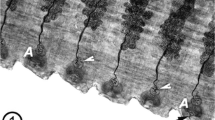Abstract
The genital region of seven species of Tubificidae has been studied by SEM (Scanning Electron Microscopy). The form and the position of penial and spermathecal chaetae, male and spermathecal pores and other special structures have been examined. Peristodrilus montanus shows a special system to hold the partner: the penial chaetae anchor in an elaborated structure of the body wall formed between the spermathecal pores, the `anchorage bridge'. Protuberodrilus tourenqui has a long glandular porophore with the male pores at the tip, allowing contact with the spermathecal pores which are located in deep, close to the mid-ventral line of the body. The grooved and strongly curved penial chaetae of Rhyacodrilus falciformis seem to be used both for attachment and for sperm transfer, entering into the lateral spermathecal pores. The embrace of the partners, as suggested by observations on Psammoryctides barbatus, Potamothrix bavaricus, Potamothrix hammoniensis and Potamothrix heuscheri, seems to be another important mechanism to fix contact between male and spermathecal pores and allow sperm transfer. The spermathecal chaetae could be interpreted as piercing chaetae with a chemical or mechanical stimulating role. Sensitive cilia near the penial chaetae seem to be used by the three rhyacodrilines studied to find the correct anchorage place. There is a great variety of structures which appear to be used for attachment and sperm transfer in tubificids, and consequently their role in the evolution of the whole family may be profound.
Similar content being viewed by others
References
Ditlevsen, A., 1904. Studien an Oligochäten. Z. wiss. Zool. 77: 398–480.
Erséus, C., 1979. Bermudrilus peniatus n. g., n. sp. (Oligochaeta, Tubificidae) and two new species of Adelodrilus from the Northwest Atlantic. Trans. am. Micros. Soc. 98: 418–427.
Erséus, C., 1981. Taxonomic Studies of Phallodrilinae (Oligochaeta, Tubificidae) from the Great Barrier Reef and the Comoro Islands with Descriptions of Ten New Species and One New Genus. Zool. Scr. 10: 15–31.
Erséus, C. & H. R. Baker, 1982. New species of the gutless marine genus Inanidrilus (Oligochaeta, Tubificidae) from the Gulf of Mexico and Barbados. Can. J. Zool. 60: 3063–3067.
Feldkamp, J., 1924. Untersuchungen über die Geschlechtsmerkmale und die Begattung der Regenwürmer. Zool. Jahrb. Anat. 46: 609–632.
Finogenova, N. P. & T. L. Poddubnaja, 1990. One more revision of the genus Potamothrix Vejdovský and Mrázek, 1902 (Oligochaeta, Tubificidae). Zool. Jb. Syst. 117: 55–83.
Giani, N., C. Erséus & E. Martínez-Ansemil, 1990. Redefinition of the subterranean genus Krenedrilus Dumnicka (Oligochaeta, Tubificidae) with a redescription of K. papillatus Dumnicka, 1983 and the description of two new species. Stygologia 5: 55–65.
Grove, A. J., 1925. On the reproductive processes of the earthworm, Lumbricus terrestris. Quart. J. Micr. Sci. 69: 245–290.
Grove, A. J. & L. F. Cowley, 1926. On the reproductive processes of the brandling worm, Eisenia foetida (Sav.). Quart. J. Micr. Sci. 70: 559–581.
Martínez-Ansemil, E. & R. Collado, 1996. Two new species of freshwater Oligochaeta from the North-west Iberian Peninsula: Krenedrilus realis sp. nov. (Tubificidae) and Cernosvitoviella bulboducta sp. nov. (Enchytraeidae). J. Zool., Lond. 240: 363–370.
Oishi, M., 1930. On the reproductive processes of the earthworm Pheretima communissima. Sci. Rep. Tohoku Imp. Univ., Ser. 4, 5: 509–524.
Omodeo, P., 1998. History of Clitellata. Ital. J. Zool. 65: 51–73.
Poddubnaya, T. L. & A. I. Pataridge, 1989. A new species of the genus Potamothrix (Oligochaeta, Tubificidae) from the high mountain lakes of the Caucasus. Zool. Zh. 68: 153–156.
Righi, G. & E. Kanner, 1979. Marine Oligochaeta (Tubificidae and Enchytraeidae) from the Caribbean sea. Studies on the fauna of Curaçao and other Caribbean islands 58: 44–68.
Stephenson, J., 1930. The Oligochaeta. Clarendon Press, Oxford: 978 pp.
Author information
Authors and Affiliations
Corresponding author
Rights and permissions
About this article
Cite this article
Cuadrado, S., Martínez-Ansemil, E. External structures used during attachment and sperm transfer in tubificids (Annelida, Oligochaeta). Hydrobiologia 463, 107–113 (2001). https://doi.org/10.1023/A:1013143322362
Issue Date:
DOI: https://doi.org/10.1023/A:1013143322362




